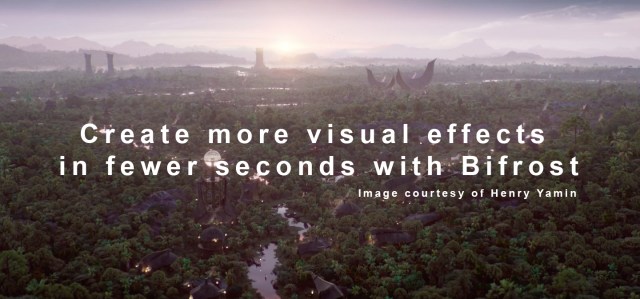What’s new in Bifrost

Improve collaboration and deliver highest-quality production values in fewer seconds with Bifrost, Maya’s visual programming environment.
This release brings you a complete overhaul of viewport volume rendering, using new “NanoVTT” technology, as well as MPM Gel, an exciting new capability that simulates substances such as soft-serve ice cream. It also introduces native support for Apple Silicon for incredible performance that will take your art further.
Deliver highest-quality production values:
You can rely on Bifrost to produce content faster and more efficiently to meet growing demands. Maya’s visual programming environment handles huge, complex files, and libraries without slowing down productivity or causing an onset of delays and missed deadlines.
Improve collaboration:
You need a tool for non-destructive, collaborative editing to tackle complex projects. Bifrost-USD enables new content, from different artists, departments, and studios, to be added non-destructively to a scene.
Improve creativity, aesthetics, and quality:
The industry is shifting from quantity to quality of productions, increasing the importance of pixel-perfect visual effects. Bifrost offers the option of building custom effects or quickly getting 90% of the way to a final effect with pre-built graphs so that you can deliver detailed, natural looking effects like smoke, fire, explosions, sand or now, no matter their level of technical expertise.
What’s new in Bifrost
Apple Silicon Support
Bifrost now runs fully natively on both Apple Silicon and Intel Macs from a universal binary to help you achieve a new level of performance. Bifrost’s just-in-time compiler, Amino, also generates native ARM64 code allowing your graphs to be compiled into native code for Apple Silicon. The SDK has also been updated to allow building plugins as Universal binaries.
NanoVTT Viewport Volume Rendering
This release introduces NanoVTT viewport volume rendering. Bifrost has a highly efficient, state-of-the-art volume representation called the “volume tile tree”, or VTT, and needs a corresponding viewport rendering solution. NanoVTT delivers this in the form of a GPU-native volume format based on NanoVDB.
As part of this work, the viewport rendering code has been revamped. Volumes in the viewport more closely match Arnold renders by supporting more of Arnold’s features. This includes volumes with voxel colors rendering in the viewport. Fire and explosions can take advantage of physically based thermodynamic emission scaling, a recently released feature of Arnold. Level sets can be assigned a standard surface material for better visualization of levelset data. Volumes now render with an alpha channel in the viewport which is particularly useful for producing playblasts that can be composited.
Finally, the optimizations allow for viewing more total voxels to accommodate larger, more complex simulations without encountering the dreaded “TDR” GPU timeouts. All of this is customizable, allowing you to define volume viewport render settings in the graph to strike the optimal balance between render quality, features, and performance.
MPM Gel
A new “gel” material has been added to the MPM solver. This material can model ice cream, cake icing, toothpaste, ketchup, melted chocolate, foam, and much more. It is customizable using physical properties such as yield stress and viscosity. Gel is integrated with the rest of the MPM system and can be used with influences, fields, and all manners of visual programming.
Enhancements to Property Transfer and Geometry Nodes
In property transfer, low-level components continue to be built to allow the implementation of geometry operations in the graph. These include nodes to transfer from multiple geometries to one geometry (“2D operations”), such as merging meshes or constructing trails from a series of point clouds.
Additionally, you can transfer properties by sampling the original geometry. These “weighted sum” operations can allow operations such as scattering points onto a mesh and sampling the underlying properties or UVs, splitting meshes, and more. These are opening up Bifrost as a no-code geometry-node building platform.
Backdrops and Sticky notes improvements
Sticky notes are now scaled automatically in height to accommodate their content. Various interactions with backdrops and sticky notes have been improved to give you a smoother experience
Contact Us
Call us on +353 (0)1 526 6717 or email sales@bluegfx.eu
